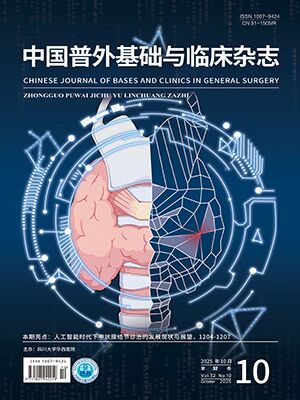| 1. |
Brown WA, Liem R, Al-Sabah S, et al. Metabolic bariatric surgery across the IFSO chapters: key insights on the baseline patient demographics, procedure types, and mortality from the Eighth IFSO Global Registry Report. Obes Surg, 2024, 34(5): 1764-1777.
|
| 2. |
Mostafa M, Bader R, Asfour G, et al. Outcomes of laparoscopic sleeve gastrectomy performed by senior surgical residents as compared to bariatric surgeons. Surg Endosc, 2025, 39(6): 3640-3647.
|
| 3. |
Kang SH, Park YS, Ahn SH, et al. Laparoendoscopic single-site bariatric surgery: a review of single-port laparoscopic and endoscopic bariatric treatments. J Obes Metab Syndr, 2018, 27(1): 25-34.
|
| 4. |
Lainas P, Derienne J, Dammaro C, et al. Single-port laparoscopic surgery for the treatment of severe obesity: review and perspectives. Obes Surg, 2020, 30(7): 2781-2790.
|
| 5. |
Stefanopoulos A, Economopoulos KP, Kalles V. Single incision laparoscopic sleeve gastrectomy: a review. Obes Surg, 2015, 25(8): 1502-1510.
|
| 6. |
García-Cabra DA, Montoya-Alvarez S, Ordorica-Flores RM, et al. Novices’ learning curve in single-port surgery using three surgical training programs. Minim Invasive Ther Allied Technol, 2024, 33(2): 90-101.
|
| 7. |
Martin M, Beekley A, Kjorstad R, et al. Socioeconomic disparities in eligibility and access to bariatric surgery: a national population-based analysis. Surg Obes Relat Dis, 2010, 6(1): 8-15.
|
| 8. |
Manueli Laos EG, Martinino A, Mangano A, et al. Disparities in bariatric surgery outcomes: a regional analysis. Obes Surg, 2024, 34(10): 3848-3856.
|
| 9. |
Yang J, Widjaja J, Wang R, et al. Routine gastric suspension technique in single-port sleeve gastrectomy procedure. Surg Endosc, 2023, 37(12): 9651-9657.
|
| 10. |
Du GS, Jiang EL, Qiu Y, et al. Single-incision plus one-port laparoscopic gastrectomy versus conventional multi-port laparoscopy-assisted gastrectomy for gastric cancer: a retrospective study. Surg Endosc, 2022, 36(5): 3298-3307.
|
| 11. |
Tranchart H, Gaillard M, Bekkhoucha S, et al. Prevention of incisional hernia after single-port sleeve gastrectomy (PRISM): a prospective non-randomized controlled study. Surg Endosc, 2022, 36(10): 7225-7232.
|
| 12. |
中华医学会外科学分会甲状腺及代谢外科学组, 中国医师协会外科医师分会肥胖和代谢病外科专家工作组. 中国肥胖及代谢疾病外科治疗指南(2024版). 中国实用外科杂志, 2024, 44(8): 841-849.
|
| 13. |
Giannopoulos GA, Tzanakis NE, Rallis GE, et al. Staple line reinforcement in laparoscopic bariatric surgery: does it actually make a difference? A systematic review and meta-analysis. Surg Endosc, 2010, 24(11): 2782-2788.
|
| 14. |
刘家盛, 李士军, 闫瑞承, 等. 单孔腹腔镜袖状胃切除术与传统腹腔镜袖状胃切除术的对比研究. 临床外科杂志, 2020, 28(9): 826-829.
|
| 15. |
杨建军, 董文培, Wadjaja Jason, 等. 单孔腹腔镜胃袖状切除术265例临床分析. 中国实用外科杂志, 2024, 44(8): 906-910.
|
| 16. |
Gaillard M, Tranchart H, Lainas P, et al. Single-port laparoscopic sleeve gastrectomy as a routine procedure in 1 000 patients. Surg Obes Relat Dis, 2016, 12(7): 1270-1277.
|
| 17. |
Aboueisha MA, Freeman M, Allotey JK, et al. Battle of the buttress: 5-year propensity-matched analysis of staple-line reinforcement techniques from the MBSAQIP database. Surg Endosc, 2023, 37(4): 3090-3102.
|
| 18. |
Cunningham-Hill M, Mazzei M, Zhao H, et al. The impact of staple line reinforcement utilization on bleeding and leak rates following sleeve gastrectomy for severe obesity: a propensity and case-control matched analysis. Obes Surg, 2019, 29(8): 2449-2463.
|
| 19. |
Diab AF, Alfieri S, Doyle W, et al. Seamguard buttressing of the staple line during laparoscopic sleeve gastrectomy appears to decrease the incidence of postoperative bleeding, leaks, and reoperations. A systematic review and meta-analysis of non-randomized comparative studies. Obes Surg, 2023, 33(7): 2237-2245.
|
| 20. |
Kang SH, Hwang D, Yoo M, et al. Feasibility of articulating laparoscopic instruments in laparoscopic gastrectomy using propensity score matching. Sci Rep, 2023, 13(1): 17384. doi: 10.1038/s41598-023-44305-1.
|
| 21. |
Ataya K, Bsat AM, Aljaafreh A, et al. Single incision versus conventional multiport laparoscopic sleeve gastrectomy: meta-analysis and systematic review. Cureus, 2023, 15(10): e46956. doi: 10.7759/cureus.46956.
|
| 22. |
D’Ugo S, Bellato V, Bianciardi E, et al. Impact of resected gastric volume on postoperative weight loss after laparoscopic sleeve gastrectomy. Gastroenterol Res Pract, 2019, 2019: 3742075. doi: 10.1155/2019/3742075.
|
| 23. |
Zhao S, Fu Y, Zhou J, et al. Comparing the efficacy of robotic versus laparoscopic sleeve gastrectomy: a systematic review and meta-analysis. Obes Surg, 2024, 34(9): 3493-3505.
|
| 24. |
Tartaglia N, Pavone G, Germano MP, et al. Relationship between residual gastric area and weight loss after sleeve gastrectomy: a cohort study. Ann Med Surg (Lond), 2021, 73: 103177. doi: 10.1016/j.amsu.2021.103177.
|
| 25. |
Mohamedahmed AYY, Hamid M, Zaman S, et al. Does omentopexy make a difference in laparoscopic sleeve gastrectomy for obesity treatment? A systematic review and meta-analysis. Obes Surg, 2024, 34(1): 218-235.
|
| 26. |
Morgantini LA, Alzein A, Bharadwaj A, et al. A prospective study on single-port versus multiport patient-reported surgical outcomes. BJUI Compass, 2023, 5(1): 84-89.
|
| 27. |
Liu ZM, Yao QJ, Pei F, et al. Efficacy and safety of reduced-port laparoscopic surgery versus conventional laparoscopic surgery for colorectal cancer. BMC Cancer, 2025, 25(1): 187. doi: 10.1186/s12885-025-13585-3.
|
| 28. |
Zarzycki P, Kulawik J, Małczak P, et al. Laparoscopic sleeve gastrectomy with omentopexy: is it really a promising method?—a systematic review with meta-analysis. Obes Surg, 2021, 31(6): 2709-2716.
|




